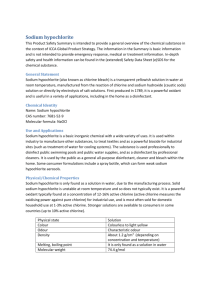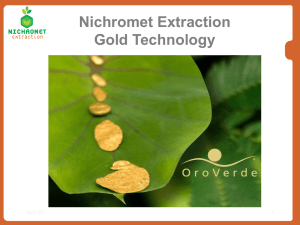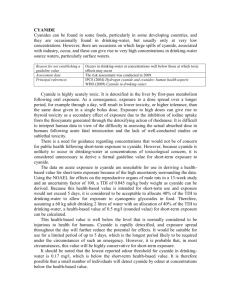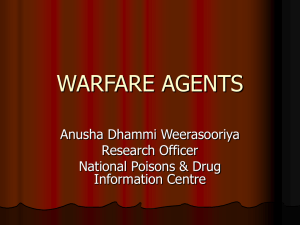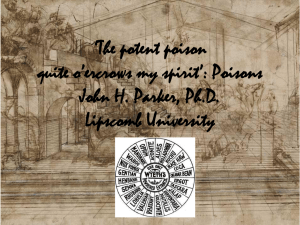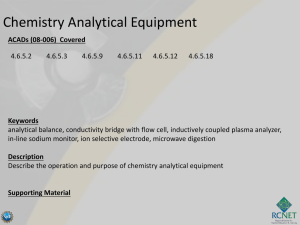Detoxification Information - Precious Metals Processing Consultants
advertisement
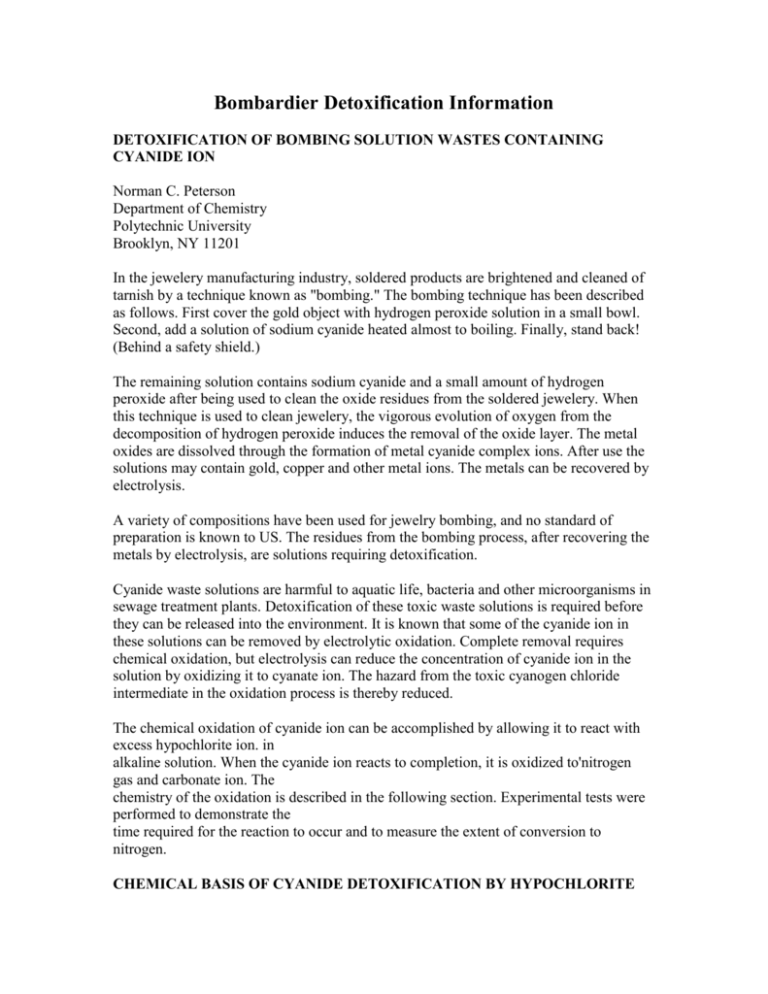
Bombardier Detoxification Information DETOXIFICATION OF BOMBING SOLUTION WASTES CONTAINING CYANIDE ION Norman C. Peterson Department of Chemistry Polytechnic University Brooklyn, NY 11201 In the jewelery manufacturing industry, soldered products are brightened and cleaned of tarnish by a technique known as "bombing." The bombing technique has been described as follows. First cover the gold object with hydrogen peroxide solution in a small bowl. Second, add a solution of sodium cyanide heated almost to boiling. Finally, stand back! (Behind a safety shield.) The remaining solution contains sodium cyanide and a small amount of hydrogen peroxide after being used to clean the oxide residues from the soldered jewelery. When this technique is used to clean jewelery, the vigorous evolution of oxygen from the decomposition of hydrogen peroxide induces the removal of the oxide layer. The metal oxides are dissolved through the formation of metal cyanide complex ions. After use the solutions may contain gold, copper and other metal ions. The metals can be recovered by electrolysis. A variety of compositions have been used for jewelry bombing, and no standard of preparation is known to US. The residues from the bombing process, after recovering the metals by electrolysis, are solutions requiring detoxification. Cyanide waste solutions are harmful to aquatic life, bacteria and other microorganisms in sewage treatment plants. Detoxification of these toxic waste solutions is required before they can be released into the environment. It is known that some of the cyanide ion in these solutions can be removed by electrolytic oxidation. Complete removal requires chemical oxidation, but electrolysis can reduce the concentration of cyanide ion in the solution by oxidizing it to cyanate ion. The hazard from the toxic cyanogen chloride intermediate in the oxidation process is thereby reduced. The chemical oxidation of cyanide ion can be accomplished by allowing it to react with excess hypochlorite ion. in alkaline solution. When the cyanide ion reacts to completion, it is oxidized to'nitrogen gas and carbonate ion. The chemistry of the oxidation is described in the following section. Experimental tests were performed to demonstrate the time required for the reaction to occur and to measure the extent of conversion to nitrogen. CHEMICAL BASIS OF CYANIDE DETOXIFICATION BY HYPOCHLORITE ION The chemical reactions taking place in the reaction of cyanide ion with hypochlorite ion have been discussed by Arnold, based on data from the chemical literature. described briefly in this section. Direct oxidation of cyaide ion (CN--) by hypochlorite ion (CIO--) will produce cyanate ion (CNO--) in alkaline solution by means of an atom transfer process as in equation (1). CN-- + C10-- --> CNO-- + C1-- (1) In addition these reactants can form (CICN), according to the chemical equation: CN- + C1O-- + H20 -> C1CN + 20H-- (4) Cyanogen chloride produced in reaction (2) undergoes hydrolysis in an alkaline solution to produce cyanate ion according to reaction (3). C1CN + 20H-- -> CNO-- + H2O + C1-- (3) When cyanogen chloride is oxidized by hypochlorite ion, nitrogen is produced by reaction (4). C1CN + 3C1O-- + 60H-- -> N2 + 2CO32-- + 5C1-- + 3H20 (4) The cyanate ion produced in steps (1) and (3) is in turn oxidized by hypochlorite ion to produce nitrogen according to reaction (5). 2CNO-- + 3C1O-- + 20H-- -> N2 + 2CO32-- + 3C1-- + H20 (5) It is evident that the oxidation of cyanide ion to nitrogen can proceed through several pathways. This can take place via reactions (1) and (5), or through reactions (2), (3) and (5), or via reactions (2) and (4). The overall process can be described by equation (6). 2CN-- + 5C1O-- + 20H-- -> N2 + 2CO32-- + 5C1-- + H20 (6) In alkaline solution in the presence of excess sodium hypochlorite, this reaction will go to completion. Eden et al. found that at pH 8 part of the cyanide was oxidized to nitrate. Some of these reactions are measureably slow and therefore sufficient time must elapse before all of the cyanide nitrogen atoms are converted to molecular nitrogen. Mapstone and Thorn measured the rate of reaction of hypochlorite with cyanide ion, i.e. the combined reactions (1) and (2). They found that these combined reactions take place on a time scale of seconds, and suggested that the two processes have similar rates. The rate of reaction of cyanogen chloride in alkaline solutions containing hypochlorite ion was measured by Eden et al. The rate of disappearance of cyanogen chloride depends on the concentration of hypochlorite ion. At pH 11, the reaction takes place on a time scale of tens of minutes under conditions where excess hypochlorite is present. Their experiment did not distinguish between reactions (3) and (4), but they showed that at pH 9 the reaction rakes place in about 15 minutes when equivalent amounts of cyanogen chloride and sodium hypochlorite are present initially. They also demonstrated that the overall reaction of potassium cyanide and hypochlorite ion (6) has a rate which depends strongly on the pH and which is much faster at pH 8 than pH 11. The time scale of the reaction is hours at pH 11. Much faster rates were reported by Mapstone and Thorn by timing the appearance of nitrogen bubbles at pH values between 9 and 10 at 18 C. It is likely that their method is only useful for measuring the initial rates. EXPERIMENTAL A solution of sodium cyanide prepared for jewelery bombing was titrated with silver nitrate to determine the concentration. The cyanide ion concentration of the room temperature solution was found to be 0.103 M. To provide a standard of comparison for the toxic waste solution, 10 ml of the sodium cyanide solution was diluted to 100 ml of solution with aqueous potassium hydroxide so that the final pH was 11. The diluted solution had a cyanide ion concentration of 0.0103 M. A solution of waste residues from jewelery bombing was obtained for testing. This solution had been electrolyzed to remove the metal ions. The cyanide concentration of a sample of this electolyzed waste bombing solution was found to be 0.016 M. This suggests the interpretation that electrolysis reduced the initially present cyanide ion concentration by as much as 80%. The electrolytic oxidation of cyanide ion produces cyanate ion. The cyanate content of the bombing solution sample was demonstrated by the amount of nitrogen produced from the hypochlorite oxidation which was in considerable excess of that expected from the cyanide ion concentration. Exactly 4 ml of sodium hypochlorite solution available chlorine 15%) was diluted to 100 ml of solution in a flask by adding potassium hydroxide of pH 11. These solutions were separately introduced into a Warburg flask, in the ratio of 2 ml of cyanide test solution to I ml of sodium hypochlorite solution. The flask was attached to a Warburg manometer and allowed to come to thermal equilibrium in a constant temperature bath regulated at 25 C. After thermal equilibrium was established, as indicated by a constant pressure, the solutions were mixed. The increase in pressure due to the formation of nitrogen gas was measured. Typical results for that measurement are shown graphically in Figure 1. A yield of 100% of the theoretical nitrogen was found after a reaction time of eight hours. Under the conditions of these experiments nitrate ion is not formed in detectable amounts. DETOXIFICATION PROCEDURE This procedure is specifically tailored to removing the cyanide ion from "bombing" solutions after the heavy metal ions have been recovered by electrolysis. Follow the instructions exactly and carefully. Cyanide ion is a toxic material and should be treated with caution. Use plastic or rubber gloves to avoid skin contact with the solution and the other chemicals. Wear safety glasses. When solutions of cyanid-e ion are made acidic, the toxic gas hydrogen cyanide can be released from the solutions. This procedure uses alkaline conditions which will not generate hydrogen cyanide. Cyanogen chloride, a poisonous gas, is an intermediate in the oxidation of cyanide ion with hypochlorite ion. Fortunately both cyanogen chloride and hydrogen cyanide are soluble in water and little of these gases escape from the solution. Good ventilation is strongly recommended, and a gas mask can be worn. Some people do not have the ability to smell cyanide compounds in the air. Should a chemical be spilled on the skin, immediately wash the affected area with large quantities of water. The following instructions assume that one has not more than 45 gallons of the electrolyzed cyanate and cyanide containing waste bombing solution in a 55 gallon drum ready for processing. Do not attempt to detoxify more than 7.5 pounds of sodium cyanide by this procedure. Extra head space is needed because of the volume of the solutions which will be added. Before beginning the detoxification process be sure that the chemical reagents are available in sufficient quantities. These materials are described in the chemicals section below. Refer to the section on amounts to find the necessary quantities of chemical reagents needed for the process. 1. Test the pH of the solution using phydrion test paper. The pH of the solution must be adjusted to 11 by the addition of caustic soda solution. Add portions of the caustic soda solution slowly. After stirring, test the pH with the test paper. continue the addition of portions of caustic soda solution with stirring until pH 11 is indicated using the test paper. 2. Refer to the section on amounts and select the volume 6f sodium hypochlorite solution needed. Add the required amount of sodium hypochlorite solution to the solution of step 1. Stir the solution and wait for fifteen minutes for the chemical reaction to occur. Bubbles of nitrogen gas can be observed. After the reaction stops generating gas bubbles, test for excess chlorine using the chlorine test paper. If chlorine is not indicated, add another one gallon portion of sodium hypochlorite solution, stir, wait and test. When excess chlorine is present allow the solution to stand overnight. 3. It is essential that excess chlorine is indicated using test paper before preceding with the next step. If the test paper does not indicate excess chlorine, this indicates that the amount of sodium cyanide was incorrectly estimated. In that event, add an additional gallon of sodium hypochlorite solution with stirring, and allow the solution to stand overnight again. If excess chlorine is indicated proceed with the next step. 4. It is essential that excess chlorine is indicated using test paper before preceding with the next step. If the test paper does not indicate excess chlorine, this indicates that the amount of sodium cyanide was incorrectly estimated. In that event, add an additional gallon of sodium hypochlorite solution with stirring, and allow the solution to stand overnight again. If excess chlorine is indicated proceed with the next step. CHEMICALS Sodium cyanide:- A solution is prepared by dissolving dry pellets (eggs) of sodium cyanide in hot water. A typical preparation is to dissolve four troy ounces of sodium cyanide in one gallon of hot water. Hydrogen peroxide:- Commercially available as a water solution, 30% hydrogen peroxide, specific gravity 1.16. Bombing solution:- A "bombing solution" is made by mixing the hot potassium cyanide solution with with the 30% solution of hydrogen peroxide in the volume ratio of 4 to 1. Sodium hypochlorite:- Commercially available as an aqueous solution containing 15% available chlorine. (Specific gravity 1.10) The commercial sodium hypochlorite with 10% available chlorine also can be used, and proportionally more solution will be required. Sulfuric acid:- Concentrated sulfuric acid (H2SO4 available gravity 1.84) commercially as 96% by weight (66 Be, specific gravity 1.84) Dilute Sulfuric acid:- Prepare a dilute solution by adding one quart of concentrated sulfuric acid slowly and with stirring to one quart of cold water. The solution will become hot, and can spatter if the mixing is done too rapidly. Sodium hydroxide (caustic soda):- Dissolve I pound of sodium hydroxide pellets in one gallon of cold water with vigorous stirring. The temperature will increase rapidly during this step. pH test paper:- An absorbing paper impregnated with several indicator compounds is available under the name phydrion. The pH of the solution describes the acidity or alkalinity on a scale of 0 to 14. A solution of pH 7 is neutral, i.e. neither acid nor alkaline. A solution of pH less than 7 is acidic. A solution of pH greater than 7 is alkaline. The pH of a solution is determined by immersing the paper in the solution and comparing the color with the standards on the package. Chlorine test paper is absorbent paper impregnated with starch acid potassium iodide is available commercially. When the test paper is immersed in a solution of sodium hypochlorite, a chemical reaction takes place, generating iodine. Iodine causes the starch to turn blue, indicating the presence of chlorine. AMOUNTS It is essential that the detoxification reaction is carried out at the specified pH and in the presence of excess sodium hypochlorite solution. The rate of the reaction depends on obtaining both of these conditions. In addition excess sodium hypochlorite is needed to be sure that all of the cyanide and cyanate in the solution is destroyed. The quantity of sodium hypochlorite to oxidize a known weight of sodium cyanide can be calculated exactly based on equation (6). It is evident that 2.5 gram moles of sodium hypochlorite is the minimum amount needed to oxidize one gram mole of sodium cyanide. The total amount of sodium cyanide used for the bombing process and collected in the waste solution is a good basis for determining the volume of sodium hypochlorite solution needed. Table I can be used to find the volume of sodium hypochlorite needed to detoxify a known weight of sodium cyanide present in the waste as a total of sodium cyanide and sodium cyanate. TABLE 1 Calculated volume of sodium hypochlorite solution required for detoxification of sodium cyanide wastes, based on the total amount of sodium cyanide originally used for the bombing process. For intermediate weights of sodium cyanide, use the next higher entry in the table. Sodium cyanide, pounds 1 1.5 2 2.5 3 3.5 4 4.5 5 5.5 6 6.5 7 7.5 Sodium Hypochlorite, gallons available chlorine 15% 10% 2 3 2.5 4 3 4.5 3.5 5.5 4 6 4.5 7 5 7.5 5.5 6 6.5 7 7.5 8 8.5 REFERENCES K. Arnold, Galvanotechnik, 57, 760 ( 1966) . G. E. Eden, B. L. Hampson and A. B. Wheatland, J. Soc. Chem. Lond., 69, 244 (1950). A. I. Gladysheva, A. I. Gutman and 1. V. Saramukova, Uch. Zap. Tsent. Nauch.-Issled. Inst. Olovyanoi Prom. No. 2, 3 (1969). (CA76(6):28118k). S. N. Joshi, Chem. Techn., 35, 465 ( 1983) . G. E. Mapstone and B. R. Thorn, J. appl. Chem. Biotechnol 135 (1978). C. C. Price, T. E. Larson, K. M. Beck, F. C. Harrington, L. C. Smith and I. Stephanoff, J. Am. Chem. Soc., 69, 1640 (1947). R . Weiner and Ch. Leiss, Metalloberflaeche, 26, 1 69 ( 1 9 7 2) W. Zabban. and R. Helwick, Plating and Surface Finishing, 56 August (1980).



